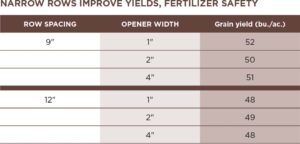Tips to improve safety of seed-placed fertilizer
Key result:
Farmers can increase the seed safety of higher phosphorus rates by increasing seed bed utilization (narrower rows or wider openers) and applying only phosphorus (not nitrogen or sulphur) fertilizer in the seed row.
Current recommendations for safe rates of seed-placed phosphorus (P) recommendations are based on one configuration: 1” opener and 9″ row spacing. At this configuration, the safe rates of seed-placed P for canola are 15, 20 and 25 lb./ac. of P2O5 for Alberta, Manitoba and Saskatchewan, respectively. However, these rates are not adequate to meet P requirements of canola. The option is to sideband or mid-row band high rates of P. Unfortunately, many farmers do not have these options and use openers that place seed and the fertilizer in the same space or near each other.
As a result, farmers often ask if they can increase seed-placed P when using a wider opener. The objectives of this project were to determine the maximum safe rate of seed-placed P fertilizer with different opener widths and row spacing, and to develop guidelines for producers and crop advisors to use.
Researchers conducted a two-year field study (2018 and 2019) at five locations: Saskatoon, Melfort and Scott in Saskatchewan, and Brooks and Lethbridge in Alberta. The study was conducted as a three-way design with the following treatments: Row spacing at 9″ and 12″; opener width at 1″, 2″ and 4″; and phosphorus rate at 20, 35, 50 and 65 lb./ac. of P2O5.
Results indicated that canola growers can apply higher rates of seed-placed phosphorus fertilizer by increasing seed bed utilization (SBU). They can do this by narrowing row spacing from 12″ to 9″ and/or increasing opener width from 1″ to 4”. Higher SBU results in reduced P toxicity and more plants per unit area.

Project title, Principal investigator:
“Reducing toxicity of seed-placed phosphorus fertilizer
in oilseed crops ,”
Patrick Mooleki,
AAFC Saskatoon
Funding:
SaskCanola,
Alberta Canola
Notable observations
Increased opener width can cause seeding problems. In many cases, the combination of 9” row spacing and 4” opener width threw too much soil on rows of front openers, which buried the seeds and reduced plant population. This problem was most pronounced on soils with a clay texture. One solution is to reduce seeding speed.
In this study, grain yield was lower with all opener sizes at 12″ row spacing than with 9″ row spacing.
While increasing P rate resulted in increased P toxicity, leading to death of some seed and seedlings, the increased amount of available P helped the surviving plants achieve higher yield.
Toxic effects of seed-placed P fertilizer were less than expected. This indicates, the researchers say, that canola can tolerate higher levels of seed-placed P when nitrogen and sulphur are not placed with the seed.
In conclusion, the researchers think that this study did not have sufficient information to change the guidelines for safe maximum rates of seed-placed P fertilizer for canola. One limitation is that the study excluded seed-placed nitrogen and sulphur, so the higher rates of seed-placed P looked safe enough.
The second limitation was the failure to separate the beneficial effect of increased P rate with the compensatory ability of a canola crop. While increasing P rate resulted in increased P toxicity, surviving plants with higher rates of P yielded better than the more numerous plants at low rates of P. The study needed to supply the same amount of P to all treatments, using the same seed-placed treatments with the balance side banded. The third limitation was time. Two years were not sufficient to lead to strong conclusions of the findings.





